Guitar tablature, affectionately known as “guitar tabs,” is a revolutionary system that empowers aspiring guitarists to dive into playing their favorite songs with remarkable speed and ease. Functioning as a visual language for music, guitar tabs share common ground with traditional music notation by illustrating notes, rhythm, and playing techniques. However, guitar tabs offer a distinct advantage, especially for beginners: they pinpoint where to play notes on the guitar fretboard.
This is particularly beneficial on the guitar, an instrument where the same note can be found in multiple locations across the fretboard. Mastering How To Read Tab For Guitar unlocks a world of musical possibilities, allowing you to learn guitar and play songs even without prior knowledge of standard musical notation.
At guitarplayers.net, we champion the use of guitar tablature as a cornerstone of learning. Guitar tabs effectively represent both chords and single notes, making them an incredibly efficient tool for learning songs quickly. The beauty of guitar tabs lies in their accessibility; deciphering them requires no specialized musical background, only a basic understanding of your guitar’s strings and frets.
If you’re eager to demystify guitar tabs and discover how they can accelerate your guitar learning journey, you’ve landed in the perfect spot. Let’s embark on this exciting exploration together!
Unveiling Guitar Tabs: What Are They?
Guitar tablature serves as a visual blueprint of music, specifically designed for guitarists. A standard guitar tab is composed of six horizontal lines, each representing one of the six strings of a guitar. When learning how to read guitar tabs, it’s crucial to understand this layout: reading from top to bottom, the lines correspond to the strings from the high E string (thinnest) to the low E string (thickest).
This arrangement mirrors the perspective of looking down at your guitar while playing. Think of guitar tablature as your personal musical roadmap, guiding you on the quickest path to playing your favorite guitar pieces.
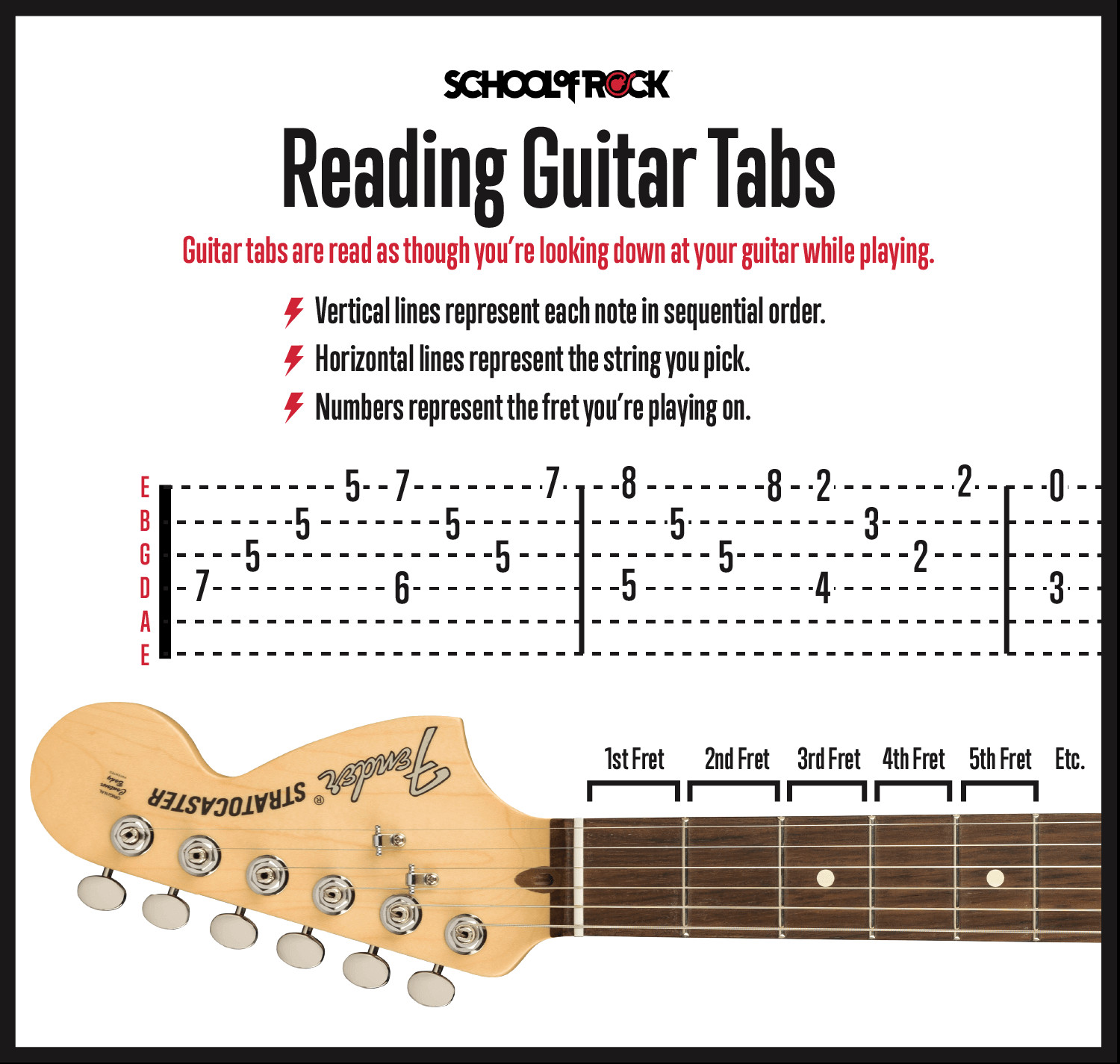 A close up view of guitar tabs showing numbers on lines representing frets and strings
A close up view of guitar tabs showing numbers on lines representing frets and strings
Within the guitar tab, you’ll notice numbers placed on these lines. These numbers are fret numbers, indicating which fret to press down on the fretboard. Frets are the metal strips running along the guitar neck, numbered 0-24 starting from the nut (closest to the headstock).
A ‘0’ on a string means playing that string “open,” without pressing down any fret. A ‘1’ signifies playing the note at the first fret, ‘2’ at the second fret, and so on. As you learn how to read tab for guitar, remember that these numbers directly correspond to the fret positions on your guitar neck.
Decoding Guitar Tabs: A Step-by-Step Guide
Reading guitar tablature is a straightforward process, moving from left to right, just like reading text. The notes in a tab are presented in the order they are played in the song. When you see numbers stacked vertically, one above another, it signifies a chord. A chord is played by strumming all the strings indicated simultaneously. Guitar tab notation is particularly advantageous for beginners because it clearly shows which notes form a chord and, crucially, where to play them on the guitar.
Essential Knowledge for Reading Guitar Tabs
To successfully learn how to read guitar tabs, beginners should first become familiar with the names and order of the 6 guitar strings and the location of the frets. This foundational knowledge will enable you to quickly translate the tab notation into finger positions on your guitar, effectively using the tab as your guide.
Understanding the Tab Staff
The guitar tab staff might visually remind you of the staff used in standard music notation, but there’s a fundamental difference. In guitar tabs, the lines represent the six guitar strings, not musical pitches.
The topmost line is the high E string, and the bottommost line is the low E string. This intuitive representation makes learning how to read guitar tabs exceptionally accessible for beginners. Tab staffs are typically labeled “TAB” to avoid confusion with standard musical notation.
Navigating Guitar Frets
Guitar frets are the thin metal strips embedded in the fretboard, running perpendicular to the strings.
Most guitars feature between 19 and 24 frets. The distance between each fret represents one semitone, or half step, in musical pitch. Within each octave, there are 12 semitones, and guitars usually have fret markers—inlays or dots—at specific fret positions like the 3rd, 5th, 7th, 9th, and 12th frets. These markers serve as visual aids for quickly locating positions on the fretboard.
Remember, in guitar tabs, numbers indicate fretted notes, while a ‘0’ denotes an open string. Playing an open string simply means plucking or picking the string without pressing down on any fret.
Deciphering Guitar Tab Chords
Guitar chords in tabs don’t have special symbols, but they are easily recognizable by their vertical alignment. When multiple numbers are stacked directly above each other in a tab, they are intended to be played together as a chord. Even if a chord is arpeggiated—played one note at a time—it will still be represented as individual notes in sequence, even though you are effectively playing the notes of a chord.
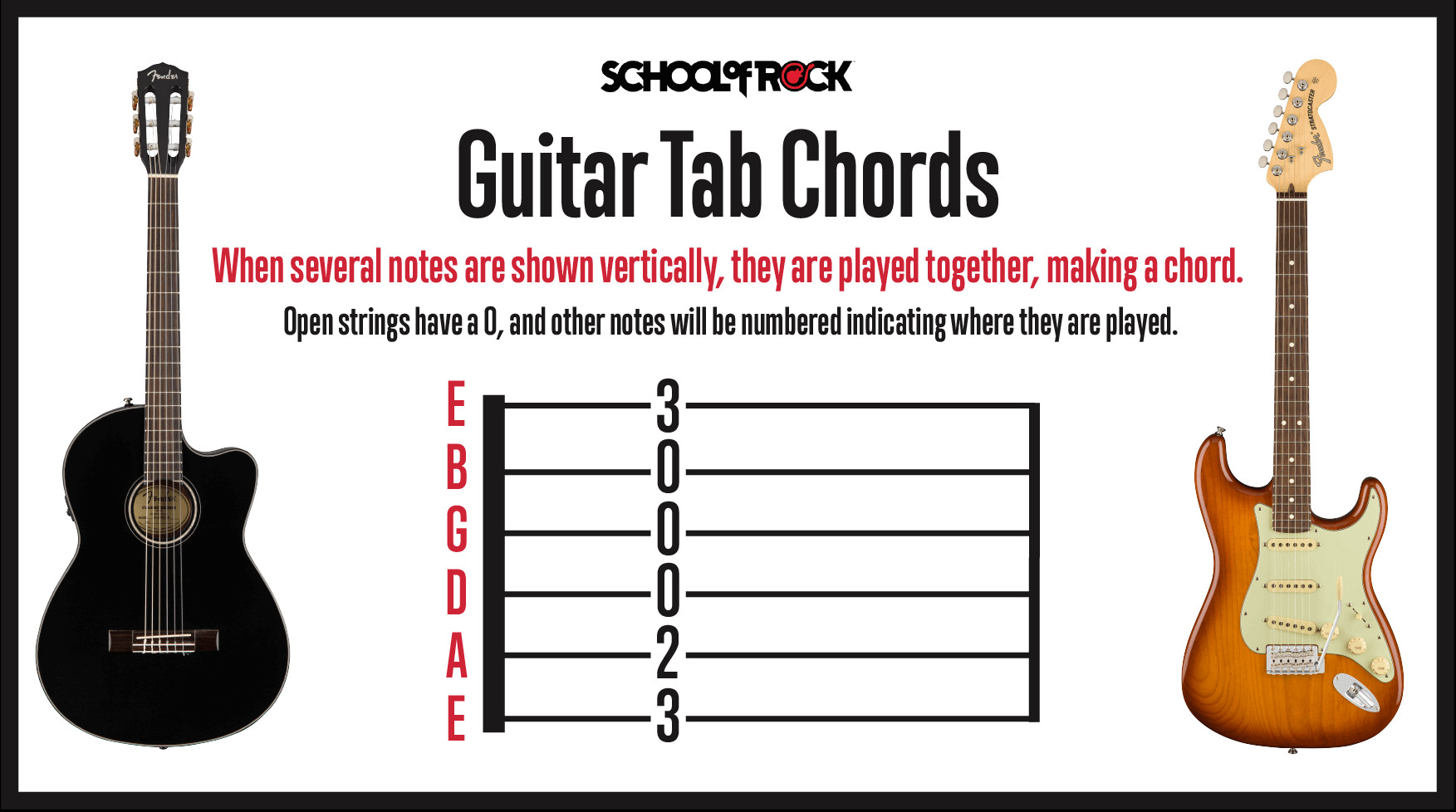 An example of guitar tab chords with vertically aligned numbers indicating notes played together
An example of guitar tab chords with vertically aligned numbers indicating notes played together
Recognizing Guitar Tab Riffs
Many popular songs, especially in rock music, are built around “riffs.” Riffs are short, repeating musical phrases, often a blend of single notes and partial chords, like power chords. When reading guitar tabs for riffs, the same principles apply: vertically aligned notes are played together, horizontally aligned notes are played sequentially. This consistency makes learning how to read guitar tablature for riffs quick and intuitive.
Guitar Tabs vs. Chord Charts: Understanding the Difference
Guitar tabs and chord charts serve different but complementary purposes. A chord chart is a visual diagram showing you where to place your fingers on the fretboard to form a specific chord. It may also suggest which fingers to use. Chord charts are often included alongside lyrics, indicating chord changes within a song.
Chord charts typically only show the root chords, focusing on the 3 or 4 core notes that define a chord. However, a full guitar arrangement may include single notes, passing tones, or arpeggios that are not explicitly shown in a chord chart. For this reason, guitar tabs are often used in conjunction with chord charts, especially for beginners, to provide a more complete and nuanced understanding of how to play a song beyond basic chord strumming.
Finger Numbering in Chord Charts
Chord charts often use a numbering system to indicate which finger to use for each note. This is particularly helpful for beginners learning chord shapes. The fingers of your fretting hand are numbered: 1 for the index finger, 2 for the middle finger, 3 for the ring finger, and 4 for the pinky finger.
This numbering is distinct from guitar tabs, where numbers represent fret numbers, not finger numbers. In easier guitar tabs, chord charts might be included to guide beginners on hand positioning for chords.
Experience the Stage: Play Guitar in Real Performances
Our guitar programs are led by experienced, practicing musicians dedicated to helping you learn to play. We offer a supportive and dynamic learning environment for all skill levels, culminating in live performances on stage. Develop your skills and unleash your musical potential with us!
Guitar Tab Symbols: Beyond Numbers and Lines
Beyond numbers and lines, guitar tabs often incorporate symbols to indicate specific playing techniques. Understanding these symbols is crucial for accurately interpreting tabs and adding authenticity to your playing. Mastering guitar tab symbols makes reading tabs even easier and more efficient. Before diving into techniques, always ensure your guitar tuning is correct to avoid playing out of pitch.
Muting Guitar Notes: Adding Depth and Dynamics
Muting is a fundamental technique, especially in genres like rock, metal, punk, and alternative. Muting techniques add rhythmic and dynamic textures to your playing.
How to Mute Notes Effectively
Muting can be achieved with either your picking hand, your fretting hand, or both. It’s a dynamic tool for controlling sustain and adding percussive elements. In many songs, muting might be applied in verses for a subdued feel and removed in choruses for impact.
Experienced guitarists often use muting intuitively to eliminate unwanted string noise, especially at higher volumes, preventing muddiness and feedback.
Palm Muting Technique
Palm muting is a widely used technique in rock guitar. It involves resting the edge of your picking hand’s palm lightly on the strings near the bridge while picking. The pressure of your palm against the strings dampens their vibration, creating a characteristic muted sound. Heavy palm muting produces a very tight, chugging sound, while lighter palm muting allows more sustain and resonance. In guitar tabs, palm muting is typically indicated by “P.M.” above the section where it should be applied.
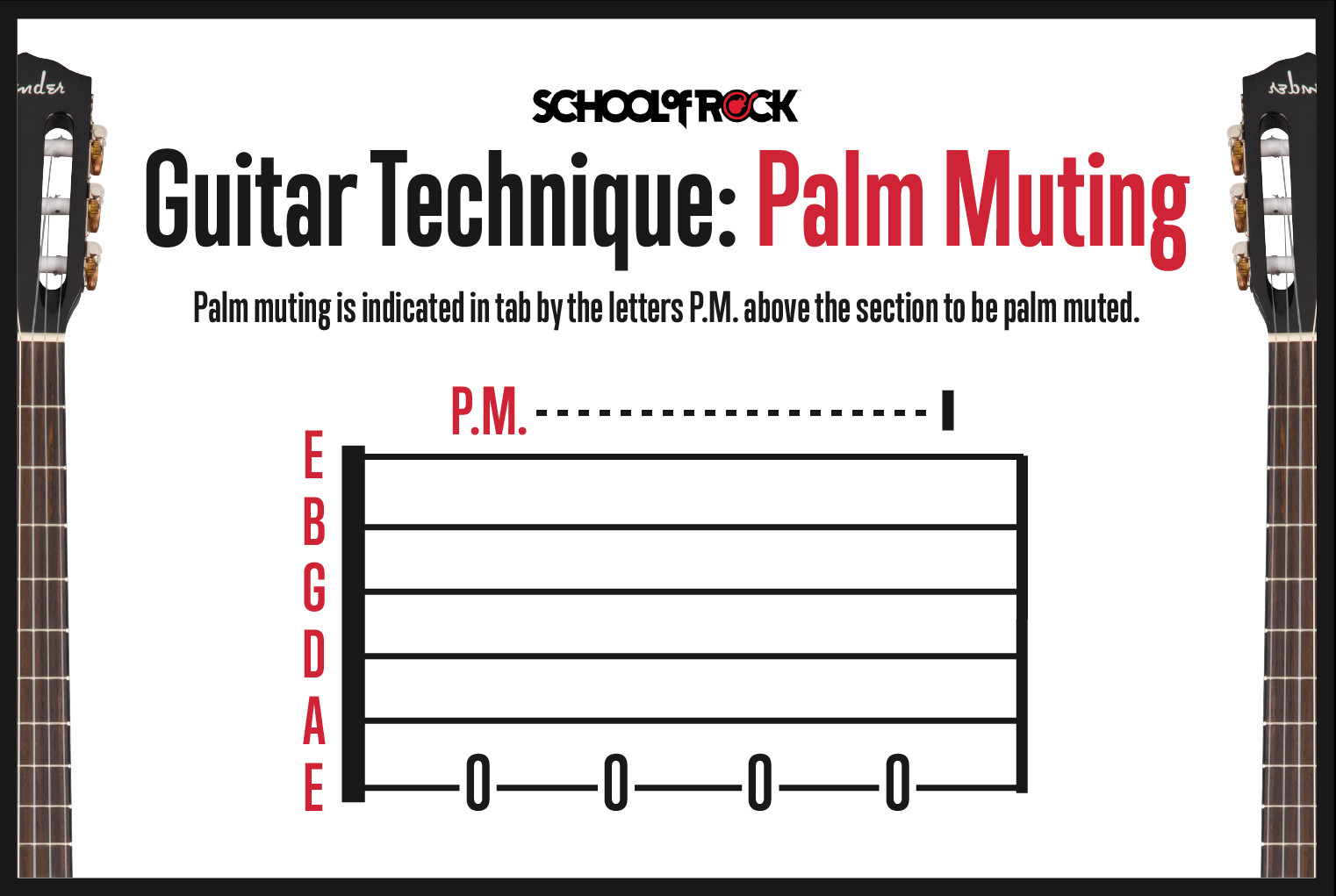 Demonstration of palm muting technique on an electric guitar
Demonstration of palm muting technique on an electric guitar
Muted Notes Technique
Muted notes, sometimes called “dead notes,” are created using the fretting hand. Instead of fully pressing down on a fret to produce a clear pitch, you lightly touch the string, just enough to dampen it but not enough to fret a clear note. When picked, these notes produce a percussive, muted sound. In guitar tabs, muted notes are represented by an “X” in place of a fret number.
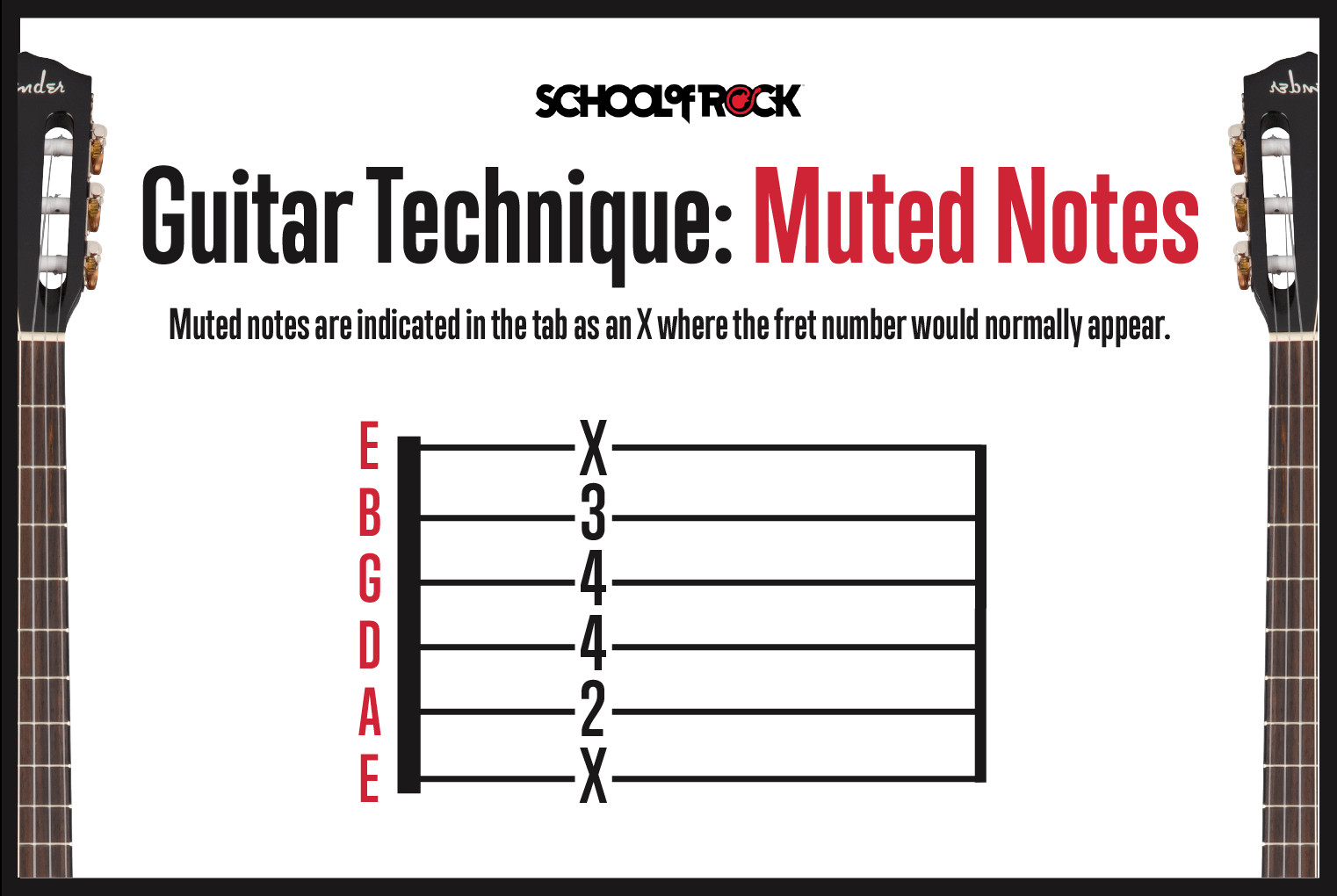 Example of muted notes in guitar tabs, represented by 'X' symbols
Example of muted notes in guitar tabs, represented by 'X' symbols
Bending Guitar Strings: Expressive Tone Shaping
String bending is a technique that adds a vocal-like expressiveness to guitar playing. Bending involves pushing or pulling a string sideways across the fretboard to raise its pitch. In guitar tabs, bends are indicated by a curved arrow above the note to be bent. The arrow may specify the bend amount, such as “½” for a half step bend (one semitone) or “full” for a whole step bend (two semitones). The target pitch of the bend is often referred to as the “target note.”
Mastering String Bending
String bending is achieved by pushing or pulling the string perpendicular to the neck, rather than just pressing down towards the fretboard. For most strings (except the low E), you’ll typically push upwards towards the ceiling. The low E string is usually bent downwards towards the floor. The key to good bending is applying smooth, consistent pressure throughout the bend.
Bending Techniques for Guitar
Most bends are executed using a combination of fingers for strength and control. Typically, the ring finger is the primary bending finger, with the middle and index fingers providing support and leverage. This multi-finger technique results in smoother bends and better pitch control.
 Illustration of bending guitar strings using multiple fingers for support
Illustration of bending guitar strings using multiple fingers for support
Pre-bending Strings
Another bending variation you might encounter in guitar tabs is the “pre-bend.” A pre-bend involves bending the string before picking it, then picking the bent note, and often releasing the bend back to the original pitch. Pre-bends are notated with an upward arrow indicating the bend amount (full, ½, etc.), followed by a downward curved arrow indicating the release. Pre-bent notes might return to their original pitch or be bent further to another target note.
Sliding Guitar Notes: Seamless Transitions
Sliding is a technique for smoothly transitioning between notes. You can slide up to a higher note or down to a lower note. Unlike bending, sliding involves moving your fretting finger along the fretboard while maintaining pressure on the string.
Slide Up Technique
In guitar tabs, a slide up is represented by a line connecting the starting note to the ending note. If the slide is to a higher pitch, the line may angle slightly upwards.
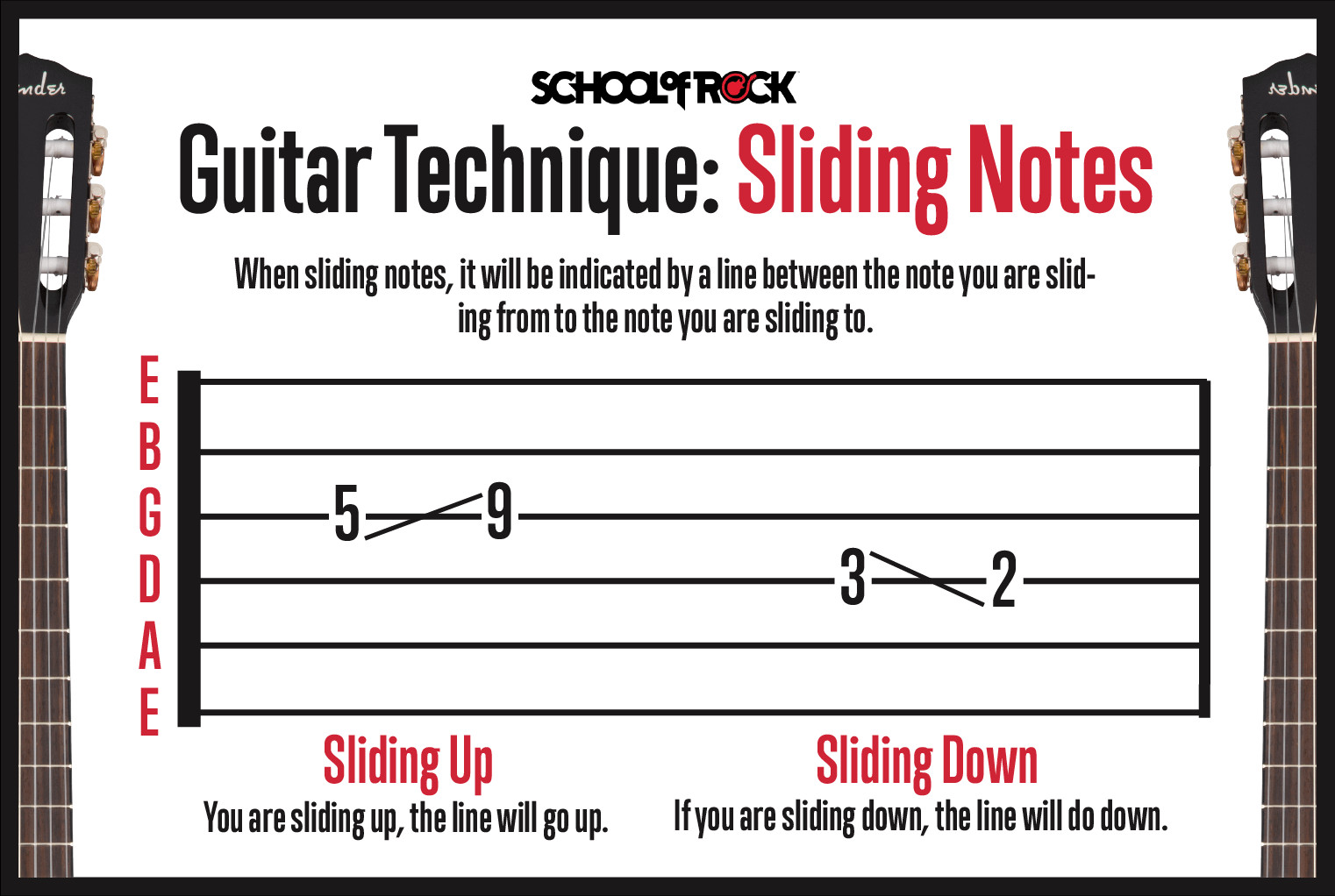 Visual representation of a slide up technique in guitar tabs
Visual representation of a slide up technique in guitar tabs
Slide Down Technique
Similarly, a slide down is shown by a line connecting the starting and ending notes. For slides to a lower pitch, the line may angle slightly downwards.
Hammer-Ons on Guitar: Articulating Notes with a Strike
The hammer-on is a technique where you articulate a note by “hammering” your fretting finger onto the string, without picking the string again. You can hammer-on from an open string or from a lower fretted note to a higher fretted note. Hammer-ons are indicated in guitar tabs with an “H” and an arc connecting the two notes.
How to Perform Hammer-Ons
To execute a hammer-on, strike the string with your fretting finger with enough force to produce a clear note. This requires a bit of practice to achieve a strong, clean sound. Hammer-ons are generally easier to perform on electric guitars, especially at higher volumes. Practice starting with an open low E string and hammer-on to the 3rd fret, letting the note ring. Repeat this exercise across different strings and fret combinations.
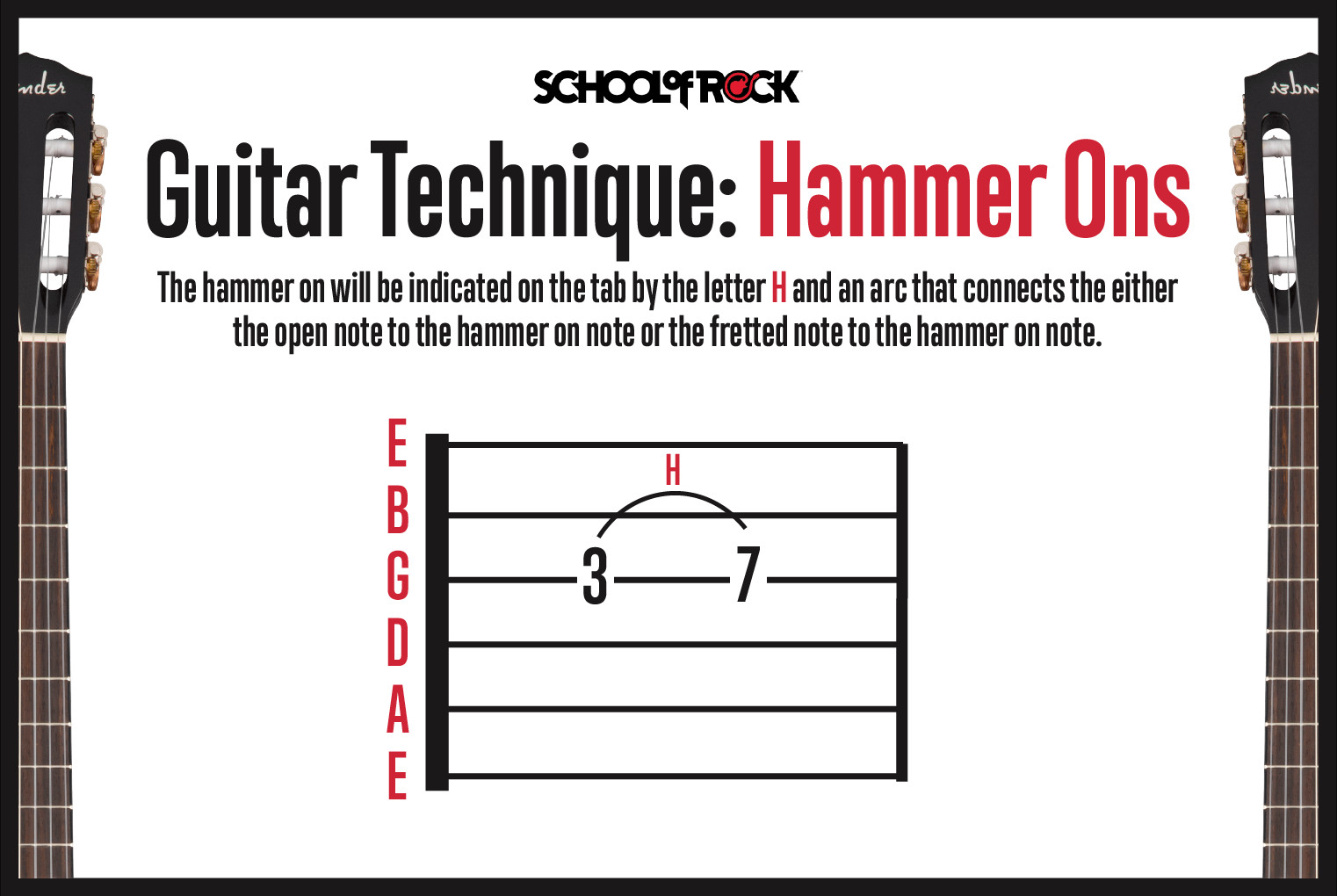 Illustration of hammer-on technique on the guitar fretboard
Illustration of hammer-on technique on the guitar fretboard
Pull-Offs on Guitar: Creating Notes by Plucking Off
Pull-offs are the opposite of hammer-ons. Instead of striking the string, you “pull off” a fretted finger to sound a lower note, which can be an open string or another fretted note held by a different finger. Pull-offs are marked in guitar tabs with a “P” and an arc connecting the two notes. The resulting note will always be lower in pitch.
How to Execute Pull-Offs
To perform a pull-off, fret a note, and then pull your fretting finger off the string in a downward or sideways motion, plucking the string just enough to sound the next note. When practicing pull-offs, ensure you “grab” enough of the string with your fingertip to create a clear tone.
Hammer-ons and pull-offs can be combined in rapid alternation, often referred to as a “trill.”
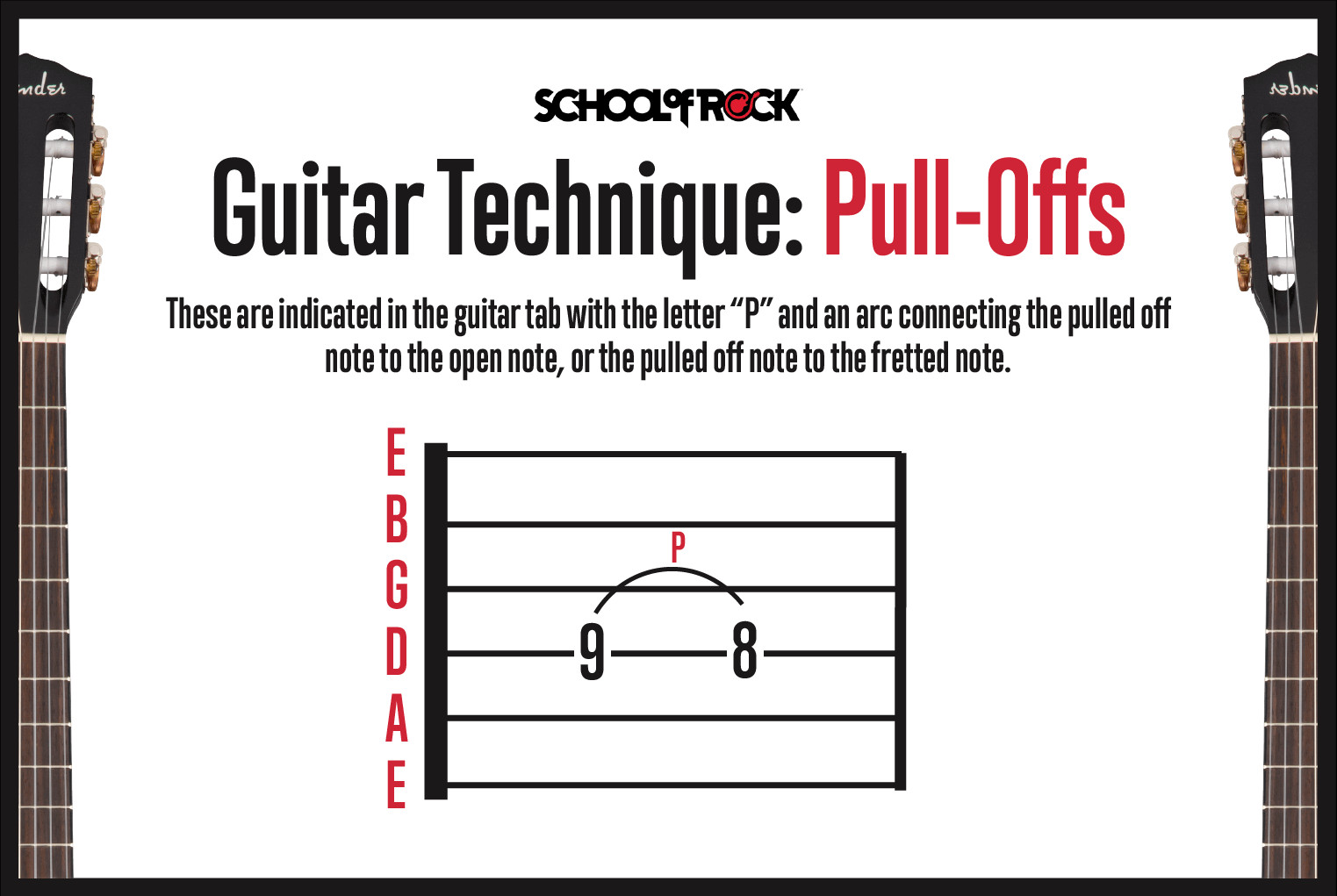 Demonstration of pull-off technique on a guitar string
Demonstration of pull-off technique on a guitar string
Vibrato on Guitar: Adding Warmth and Expression
Vibrato is a technique that adds warmth and expressiveness to sustained notes. It involves subtly and rapidly varying the pitch of a note by repeatedly bending and releasing the string without fully releasing pressure. In guitar tabs, vibrato is represented by a zig-zag line above the staff. The length of the zig-zag line often indicates the duration of the vibrato effect.
How to Apply Vibrato
Vibrato is similar to bending but with a much smaller pitch variation. You can apply vibrato using a single finger or by using multiple fingers for support, similar to bending. Start practicing with a slow, smooth vibrato, and gradually experiment with different speeds and widths to achieve various expressive qualities. Like bending, vibrato is a highly personal technique; every guitarist’s vibrato is unique, contributing to their individual style.
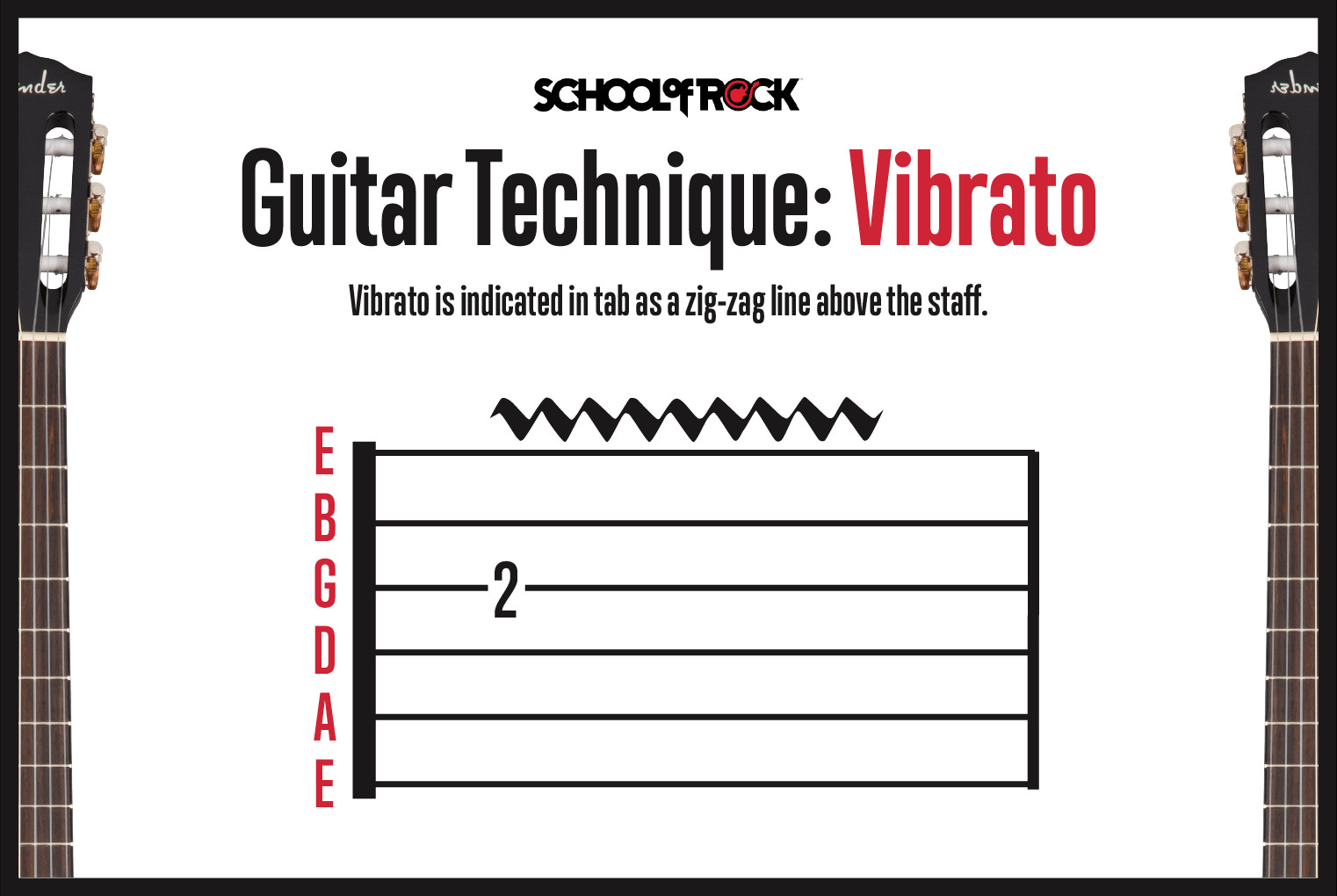 Example of vibrato notation in guitar tabs and hand position for vibrato technique
Example of vibrato notation in guitar tabs and hand position for vibrato technique
Tapping on Guitar: Two-Handed Fretboard Artistry
Tapping is an advanced technique that involves using both hands to fret notes on the fretboard. Typically, you fret notes with your regular fretting hand and then “tap” or hammer-on notes with the index finger of your picking hand. Tapping with the picking hand is essentially a variation of a hammer-on. In guitar tabs, tapping is notated with a “T” above the tapped note.
Finger Tapping Techniques
Tapping gained mainstream popularity thanks to Eddie Van Halen, although the technique has roots in classical guitar. To finger tap, fret a note with your fretting hand and then sharply tap a higher fret on the same string with your picking hand’s index finger.
Finger tapping expands your playing range, allowing you to play wide intervals and fast passages that are difficult or impossible with just your fretting hand. Playing with overdrive or distortion enhances the clarity and sustain of tapped notes. Two-handed tapping also enables very rapid playing, as both hands are actively fretting notes.
 Demonstration of two-handed tapping technique on electric guitar
Demonstration of two-handed tapping technique on electric guitar
Two-Handed Tapping
Two-handed tapping takes the concept further, with both hands independently tapping notes on the fretboard without traditional picking. This can involve the fretting hand tapping bass notes while the picking hand taps melody or solo lines, creating complex and layered textures.
Strumming Guitar Notes: Rhythmic Foundation
When playing chords, strumming provides the rhythmic foundation. There are two primary strumming directions: downstrokes and upstrokes.
Downstrokes: A downstroke is played from the thicker, lower strings towards the thinner, higher strings using a downward motion of your pick or strumming hand. In guitar tabs, downstrokes are represented by a symbol resembling a thick horizontal line with two short legs pointing downwards on either side.
Upstrokes: An upstroke is the opposite, played from the thinner, higher strings to the thicker, lower strings with an upward motion. Upstrokes in guitar tablature are notated by a “V” shaped symbol.
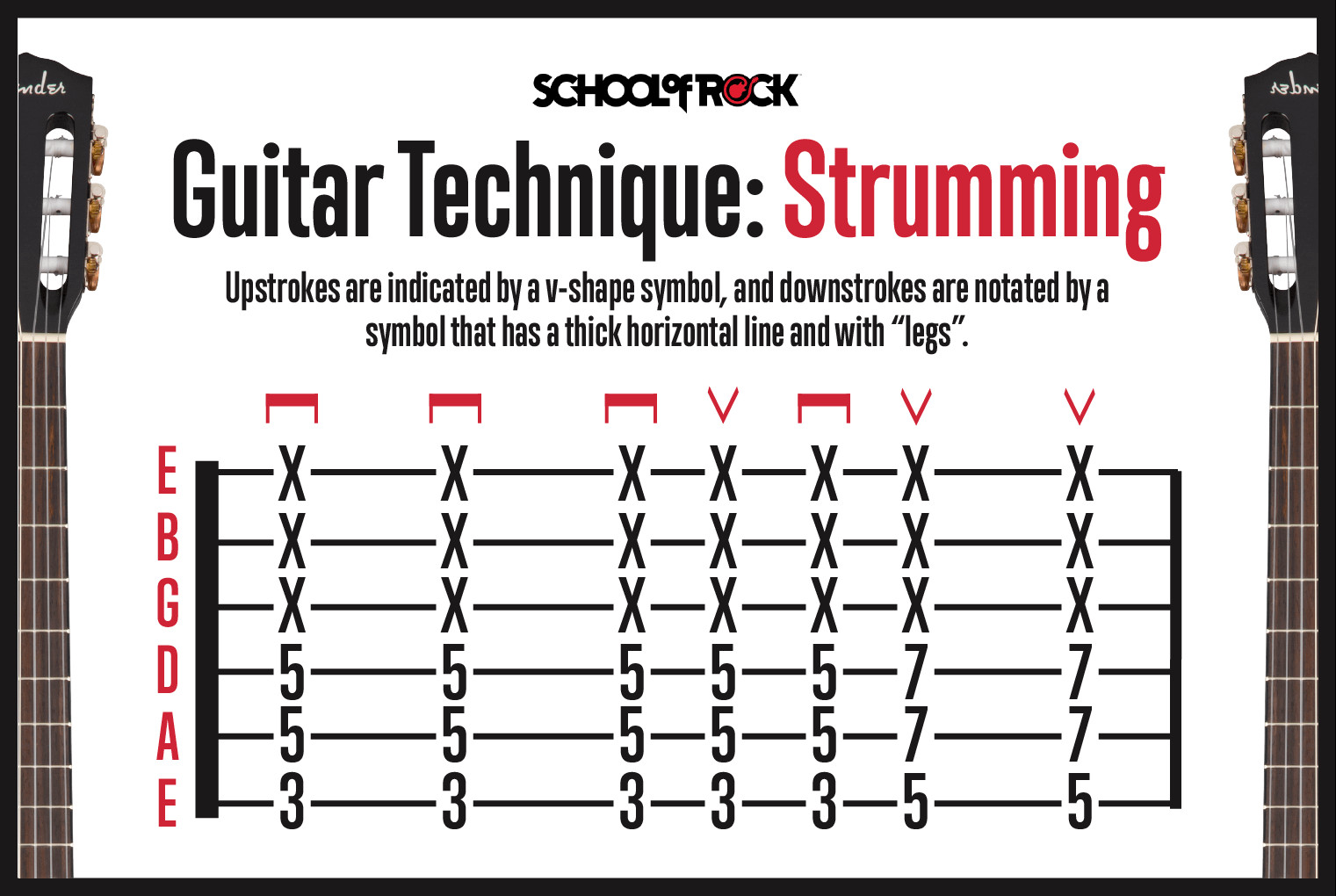 Guitar tab notation for downstrokes and upstrokes in strumming
Guitar tab notation for downstrokes and upstrokes in strumming
Mastering Strumming Patterns
Strumming patterns create the rhythm and groove of a song. You can use consistent downstrokes, consistent upstrokes, or, more commonly, a combination of both. Many songs utilize eighth-note rhythms, counted as “1 and 2 and 3 and 4 and…” Alternating downstrokes and upstrokes on each eighth note is a common pattern, with downstrokes typically falling on the numbered beats (1, 2, 3, 4) and upstrokes on the “ands.”
Downstrokes and Upstrokes for Single Notes
The same downstroke and upstroke notation applies to single notes in guitar tabs. A downstroke symbol indicates picking the note with a downward motion, and an upstroke symbol indicates picking with an upward motion. These directional strokes can influence the attack and tone of individual notes.
Ready to Explore More Guitar Techniques?
Now that you’ve learned how to read tab for guitar and understand common guitar techniques, you’re well-equipped to start playing a vast repertoire of music. From beginner-friendly strumming to advanced tapping, guitarplayers.net is dedicated to helping guitarists of all levels reach their musical aspirations. Our comprehensive resources and guides are here to support your journey.
Eager to find guitar tabs to play? From easy beginner songs to challenging pieces for advanced players, we’ve got you covered. Explore our curated collection of high-quality guitar tabs and sheet music to find your next song to learn!
Thinking about getting a new guitar? Check out our Guitar Buying Guide for expert advice to help you choose the perfect instrument!

